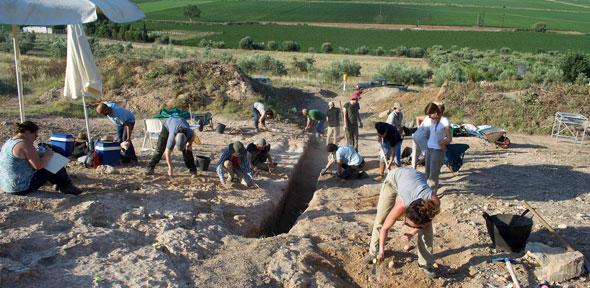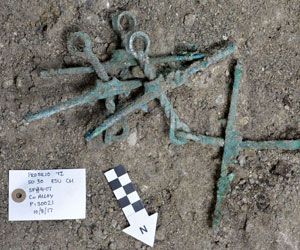New type of supercomputer could be based on ‘magic dust’ combination of light and matter

A team of researchers from the UK and Russia have successfully demonstrated that a type of ‘magic dust’ which combines light and matter can be used to solve complex problems and could eventually surpass the capabilities of even the most powerful supercomputers.
One referee said, ‘Who would be crazy enough to try to implement this?!’
Natalia Berloff
The researchers, from Cambridge, Southampton and Cardiff Universities in the UK and the Skolkovo Institute of Science and Technology in Russia, have used quantum particles known as polaritons – which are half light and half matter – to act as a type of ‘beacon’ showing the way to the simplest solution to complex problems. This entirely new design could form the basis of a new type of computer that can solve problems that are currently unsolvable, in diverse fields such as biology, finance or space travel. The results are reported in the journal Nature Materials.
Our technological progress — from modelling protein folding and behaviour of financial markets to devising new materials and sending fully automated missions into deep space — depends on our ability to find the optimal solution of a mathematical formulation of a problem: the absolute minimum number of steps that it takes to solve that problem.
The search for an optimal solution is analogous to looking for the lowest point in a mountainous terrain with many valleys, trenches, and drops. A hiker may go downhill and think that they have reached the lowest point of the entire landscape, but there may be a deeper drop just behind the next mountain. Such a search may seem daunting in natural terrain, but imagine its complexity in high-dimensional space. “This is exactly the problem to tackle when the objective function to minimise represents a real-life problem with many unknowns, parameters, and constraints,” said Professor Natalia Berloff of Cambridge’s Department of Applied Mathematics and Theoretical Physics and the Skolkovo Institute of Science and Technology, and the paper’s first author.
Modern supercomputers can only deal with a small subset of such problems when the dimension of the function to be minimised is small or when the underlying structure of the problem allows it to find the optimal solution quickly even for a function of large dimensionality. Even a hypothetical quantum computer, if realised, offers at best the quadratic speed-up for the “brute-force” search for the global minimum.
Berloff and her colleagues approached the problem from an unexpected angle: What if instead of moving along the mountainous terrain in search of the lowest point, one fills the landscape with a magical dust that only shines at the deepest level, becoming an easily detectible marker of the solution?
“A few years ago our purely theoretical proposal on how to do this was rejected by three scientific journals,” said Berloff. “One referee said, ‘Who would be crazy enough to try to implement this?!’ So we had to do it ourselves, and now we’ve proved our proposal with experimental data.”
Their ‘magic dust’ polaritons are created by shining a laser at stacked layers of selected atoms such as gallium, arsenic, indium, and aluminium. The electrons in these layers absorb and emit light of a specific colour. Polaritons are ten thousand times lighter than electrons and may achieve sufficient densities to form a new state of matter known as a Bose-Einstein condensate, where the quantum phases of polaritons synchronise and create a single macroscopic quantum object that can be detected through photoluminescence measurements.
The next question the researchers had to address was how to create a potential landscape that corresponds to the function to be minimised and to force polaritons to condense at its lowest point. To do this, the group focused on a particular type of optimisation problem, but a type that is general enough so that any other hard problem can be related to it, namely minimisation of the XY model which is one of the most fundamental models of statistical mechanics. The authors have shown that they can create polaritons at vertices of an arbitrary graph: as polaritons condense, the quantum phases of polaritons arrange themselves in a configuration that correspond to the absolute minimum of the objective function.
“We are just at the beginning of exploring the potential of polariton graphs for solving complex problems,” said co-author Professor Pavlos Lagoudakis, Head of the Hybrid Photonics Lab at the University of Southampton and the Skolkovo Institute of Science and Technology, where the experiments were performed. “We are currently scaling up our device to hundreds of nodes, while testing its fundamental computational power. The ultimate goal is a microchip quantum simulator operating at ambient conditions.”
Reference:
Natalia G. Berloff et al. ‘Realizing the classical XY Hamiltonian in polariton simulators.’ Nature Materials (2017). DOI: 10.1038/nmat4971

The text in this work is licensed under a Creative Commons Attribution 4.0 International License. For image use please see separate credits above.





 Once huge quantities of soil and rubble had been carefully excavated, the archaeologists found in the chamber the remains of a man, aged 40 to 50 years. He was accompanied by a selection of fine objects: jewellery made in a range of materials, combs, pins, a pair of horse bits, arrowheads, a bow, a sealstone, a signet ring, and a group of tinned clay vessels of various shapes.
Once huge quantities of soil and rubble had been carefully excavated, the archaeologists found in the chamber the remains of a man, aged 40 to 50 years. He was accompanied by a selection of fine objects: jewellery made in a range of materials, combs, pins, a pair of horse bits, arrowheads, a bow, a sealstone, a signet ring, and a group of tinned clay vessels of various shapes.





















